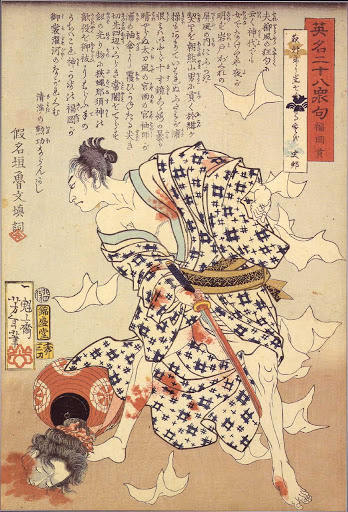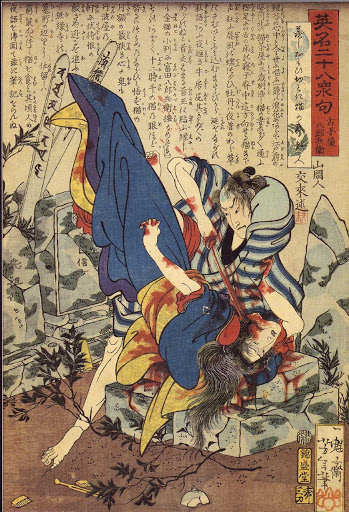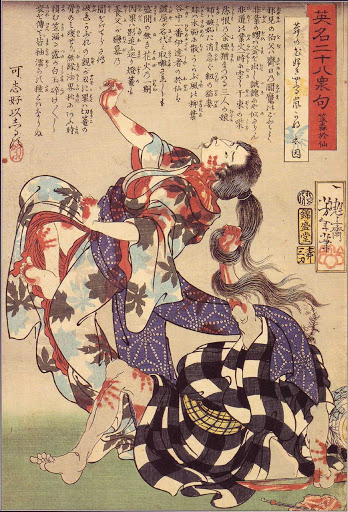Shiva Nataraja – The Hindu Lord of the Dance. Iconography and Symbolism
Nataraja, the manifestation of the Hindu god Shiva as the Lord of the Dance, holds a profound significance in Hindu mythology and symbolism. Depicted...
Maya M. Tola 3 June 2024
31 October 2023 min Read
For centuries, gore has been part of the culture in Japan, rooted in its history. Its representation is very common in woodblock engraving pictures. Muzan-e, the “bloody prints”, is a genre par excellence. This kind of art may be the very first example of ero guro, an erotic and grotesque art, nowadays practiced in manga. The very first exponent of this curious style was Tsukioka Yoshitoshi (1839-1892), also known as Taiso Yoshitoshi. He was one of the masters of ukiyo-e, “pictures of the floating world”.
He criticized the social and moral decline through his art, portraying it perfectly. Yoshitoshi suffered the cruel laws of his time imposed by the Tokugawa Shogunate (1600-1868). Several wars occurred in those years, and the impact of the westerners was evident. He was creating these prints in order to exorcise himself from the pain. However, his art gives off a singular beauty, making those extreme violent scenes seem delicate.

In 1863 Yoshitoshi’s father died, and his death became one of his biggest inspirations, along with the cruel and violent laws enforced at that moment. It was a way to capture his own fears and demons, as seen in the following artworks.

Within this series we can find one of the most famous pieces, entitled: Eimei nijūhasshūku (英名 二十八 衆句), 28 famous murders with verse. These beautiful prints were accompanied by small fragments of poetry, representing brutal situations based on kabuki plays and historical events. Muzan-e represented atrocities and explicit images, this series being the first example of the genre. The compositions, colors used, pattern design, and many details are unique.

Furuteya Hachirōbei murdering a woman in a graveyard is the best-known print from the series. The protagonist here is not the murderer but the victim; a woman whose skin is being torn into strips. She is falling diagonally, which is highlighted by her clothes, marking the entire composition of the picture. It makes it easier to read, as the viewer follows the falling line. In the scene, there is a certain depth, formed by the rocky landscape, but the main focus is the murder. Yoshitoshi is so detailed that even the colors of the robes have been deliberately chosen to compensate for the visual weight of the image, allowing the audience to better understand what is happening.

Serial prints were common in the ukiyo-e technique. It was a format that was bound or transformed into scrolls for personal collection or use.
Despite the brutal theme, they were highly successful. The public admired and enjoyed these illustrations, full of color, dynamism, and violence. The shown murders are very graphic or explicit, but still very subtle. They seem to be frozen in time, in full swing. The floating robes especially stand out due to the sudden movements of the characters, and how the fabric of these present all the imaginable qualities, patterns and textures. It is important to understand how surreal those situations are according to physics, as seen in the following artwork.


Muzan-e influenced many mangaka such as Suehiro Maruo, Shintaro Kago, and Toshido Maeda. It had also a strong influence on Japanese cinema and other doctrines, reflecting ruthlessness in elegant ways. Tsukioka Yoshitoshi definitely had a huge impact on coetaneous ukiyo-e artists, being one of the first creators of muzan-e.
DailyArt Magazine needs your support. Every contribution, however big or small, is very valuable for our future. Thanks to it, we will be able to sustain and grow the Magazine. Thank you for your help!